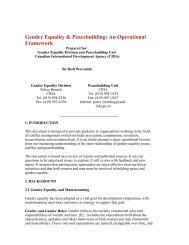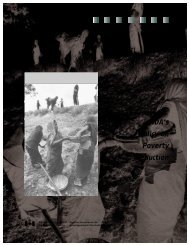Concepts and practices in agricultural extension in developing ...
Concepts and practices in agricultural extension in developing ...
Concepts and practices in agricultural extension in developing ...
- No tags were found...
Create successful ePaper yourself
Turn your PDF publications into a flip-book with our unique Google optimized e-Paper software.
• An appropriate adm<strong>in</strong>istrative or organizational structure exists with<strong>in</strong> which the dissem<strong>in</strong>ationactivities may be established <strong>and</strong> conducted.• There is a legislative or some other official m<strong>and</strong>ate or <strong>in</strong>fluential proponents, which prescribes orenables that <strong>agricultural</strong> <strong>extension</strong> work is desirable <strong>and</strong> must occur.• There are <strong>in</strong>variably a variety of antecedents, which have attempted protoforms (basicframes, used until a more suitable form can be found) of <strong>agricultural</strong> <strong>in</strong>formation <strong>and</strong> advicedissem<strong>in</strong>ation.• The <strong>in</strong>cidence of critical situations, such as fam<strong>in</strong>e, crop failure, soil exhaustion, or alteredeconomic conditions or relationship may create an immediate cause for <strong>in</strong>itiat<strong>in</strong>g the organizationof <strong>extension</strong> work <strong>in</strong> the form of mass campaigns.2.2.1 Pre-<strong>in</strong>dependenceIn this era, emphasis was placed on commodity programs—expatriate ‘rural agents’ to organizecommunities <strong>and</strong> serve as contact po<strong>in</strong>ts for government authorities, <strong>in</strong>put <strong>and</strong> credit suppliers <strong>and</strong>buy<strong>in</strong>g agents. Their broadly def<strong>in</strong>ed roles often extended <strong>in</strong>to human health, census tak<strong>in</strong>g <strong>and</strong> taxcollection.2.2.2 Immediate post-<strong>in</strong>dependenceCharacteristics of the period between the late 1950s <strong>and</strong> 1960s:• <strong>in</strong>stitutionalization of many national <strong>extension</strong> services• <strong>agricultural</strong> <strong>extension</strong> became attached to the M<strong>in</strong>istry of Agriculture• confidence <strong>in</strong> western technology led to the adoption of ‘diffusion model’ or ‘Technology Transfermodel’ of <strong>extension</strong> delivery—a hierarchical process of technology transfer backed by advances <strong>in</strong>mass media• focus was also on <strong>in</strong>terpersonal communication <strong>and</strong> community development• the <strong>agricultural</strong> service was multifunctional, with weak connections to <strong>agricultural</strong> research• <strong>extension</strong> agents were entrusted with a variety of functions rang<strong>in</strong>g from credit delivery, <strong>in</strong>putsdistribution, <strong>and</strong> sundry coord<strong>in</strong>ation duties such as: clerical, statistical, or even political chores.2.2.3 Extension <strong>in</strong> the 1970sDur<strong>in</strong>g the 1970s, the <strong>extension</strong> systems <strong>in</strong> develop<strong>in</strong>g countries changed as the realization cameabout that there was a need to reach more farmers <strong>and</strong> to better tra<strong>in</strong> <strong>extension</strong> agents. The ma<strong>in</strong>developments <strong>in</strong>cluded <strong>in</strong>tegrated rural development approaches, <strong>and</strong> the emergence of Tra<strong>in</strong><strong>in</strong>g <strong>and</strong>Visit (T&V) <strong>extension</strong> systems. The ‘diffusion model’ of <strong>extension</strong> gave way to the ‘get the technologyright’ model, where farm-level constra<strong>in</strong>ts expla<strong>in</strong>ed non-adoption of technology, with a prescriptionto ease the constra<strong>in</strong>ts through <strong>in</strong>tegrated packages of services (Ax<strong>in</strong>n 1988).This ushered <strong>in</strong> the World Bank-sponsored Tra<strong>in</strong><strong>in</strong>g <strong>and</strong> Visit System (T&V). This system used contactfarmers <strong>in</strong> order to multiply <strong>extension</strong>’s effect. Be<strong>in</strong>g highly structured, this system was top–down <strong>and</strong>characterized by rigidity <strong>and</strong> high costs. Fund<strong>in</strong>g often came through loans from the World Bank.Work<strong>in</strong>g ma<strong>in</strong>ly with contact farmers stifled diversity, because many were large scale male farmerswho had little <strong>in</strong> common with small-scale resource-poor farmers.The T&V system was designed to address some of the weaknesses <strong>in</strong> the previous <strong>extension</strong> approaches,such as weak l<strong>in</strong>kages with research <strong>and</strong> limited tra<strong>in</strong><strong>in</strong>g of field <strong>extension</strong> workers. As its name suggests,34





